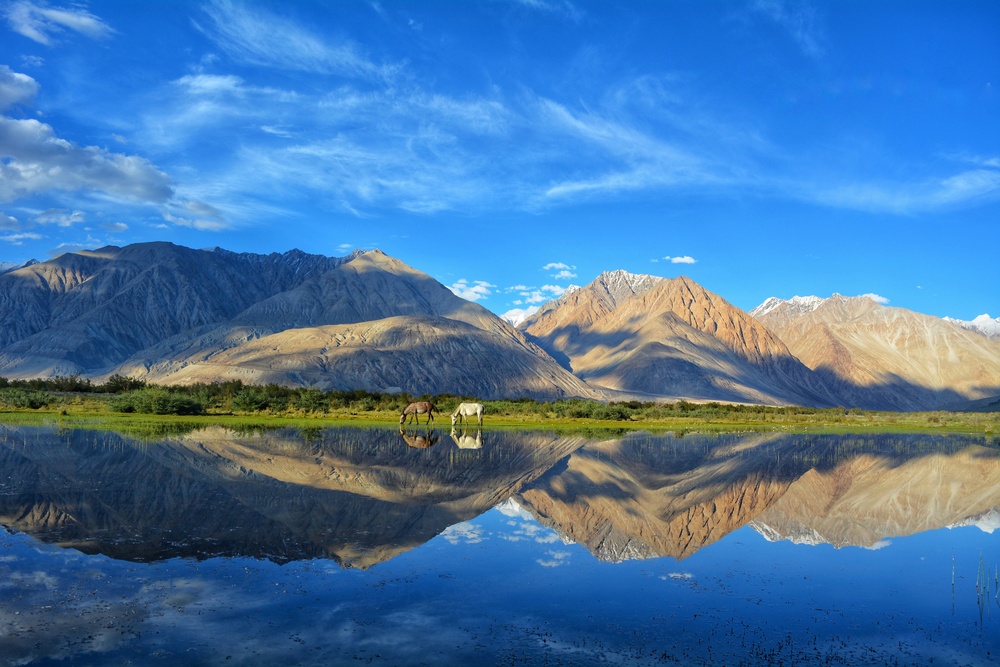Ladakh Tourism offers travellers an unforgettable experience of rugged mountain landscapes, ancient monasteries, pristine lakes, and rich cultural heritage. Located in the northernmost part of India, Ladakh is often called the ‘Land of High Passes,’ where each turn reveals breathtaking views, making it a dream destination for nature lovers, bikers, trekkers, and photographers.
Leh – The Gateway to Ladakh
Leh, the largest town and the capital of Ladakh, is the starting point of Ladakh Tourism. At an altitude of 11,500 feet, Leh offers a mix of ancient Buddhist culture and modern cafes, markets, and homestays. The Leh Palace, a 17th-century palace resembling Potala Palace of Lhasa, overlooks the town and provides panoramic views of the valley.
The bustling Leh market is ideal for buying Tibetan handicrafts, prayer flags, pashmina shawls, and traditional jewellery. The Shanti Stupa, built by Japanese monks, is a peaceful white-domed structure offering stunning sunrise and sunset views over Leh and the Stok Kangri range.
Monasteries – Spiritual Hubs of Ladakh
Monasteries are among the highlights of Ladakh Tourism. Hemis Monastery, the largest in Ladakh, is famous for its colourful Hemis festival with masked dances celebrating Guru Padmasambhava. Thiksey Monastery, located 19 km from Leh, resembles a mini Potala Palace and houses a 49-feet tall Maitreya Buddha statue in its main hall.
Diskit Monastery in Nubra Valley is the oldest and largest monastery in the region, overlooking the valley with its massive 106-feet statue of Maitreya Buddha. Other notable monasteries include Spituk, Alchi (known for its Kashmiri-influenced murals), and Lamayuru, the oldest monastery situated in a moon-like landscape.
Pangong Lake – A Breathtaking Himalayan Gem
Pangong Tso is one of the most famous attractions of Ladakh Tourism. Located at an altitude of 14,270 feet, this 134 km-long lake stretches from India into Tibet. Its turquoise waters change shades with the sun, creating surreal landscapes surrounded by barren mountains. Pangong gained popularity after featuring in Bollywood movies like 3 Idiots. Staying overnight in lakeside camps under a blanket of stars is an experience of a lifetime.
Nubra Valley – Desert in the Mountains
Another must-visit destination in Ladakh Tourism is Nubra Valley. Accessible via Khardung La, one of the world’s highest motorable passes at 18,380 feet, Nubra Valley surprises travellers with its contrasting landscapes of sand dunes, green oasis villages, and snow peaks.
The village of Hunder is famous for its white sand dunes and double-humped Bactrian camels, offering unique desert safaris amidst Himalayan backdrops. Diskit Monastery and the nearby hot springs of Panamik add to Nubra’s charm.
Tso Moriri – The High-Altitude Lake
Tso Moriri is a serene high-altitude lake located in the Changthang region at 15,075 feet. Unlike Pangong, Tso Moriri sees fewer tourists, making it ideal for peaceful reflection amidst nature. The lake is surrounded by snow-capped peaks and is home to migratory birds like Brahminy ducks and bar-headed geese during summer, adding to its pristine beauty.
Khardung La – Conquering Heights
Khardung La Pass, an iconic destination in Ladakh Tourism, connects Leh to Nubra Valley. The thrill of driving or biking over this high-altitude pass is unmatched, with prayer flags fluttering against dramatic mountain scenery. Due to its height, travellers should acclimatise in Leh before crossing Khardung La to avoid altitude sickness.
Magnetic Hill and Sangam Point
Magnetic Hill, near Leh on the Leh-Kargil highway, is a popular attraction where vehicles appear to move uphill against gravity due to optical illusion. Nearby is the Sangam, the confluence of the Zanskar and Indus rivers, where the emerald green Indus meets the muddy Zanskar, creating a beautiful sight. Adventure seekers can enjoy white-water rafting on the Zanskar River here.
Zanskar Valley – Offbeat Adventure
For those seeking offbeat experiences, Zanskar Valley is a hidden gem of Ladakh Tourism. The valley remains cut off from the rest of the world for nearly 8 months due to heavy snowfall. In summer, it offers trekking, camping, and river rafting opportunities. The famous Chadar Trek on the frozen Zanskar River in winter is a challenging yet once-in-a-lifetime experience for adventure lovers.
Culture and Festivals
Ladakh Tourism is deeply rooted in Tibetan Buddhist culture. Festivals like Hemis, Losar (Tibetan New Year), and Dosmoche are celebrated with traditional masked dances, rituals, and fairs. The people of Ladakh, mostly of Tibetan descent, are warm and hospitable, welcoming travellers into their homes for authentic experiences of local food and lifestyle.
Best Time to Visit
The best time to explore Ladakh Tourism is from May to September when roads from Srinagar and Manali are open, and the weather is pleasant for sightseeing, biking, and trekking. Winters are harsh with temperatures dipping below -20°C, but it is the season for unique experiences like the Chadar Trek.
Final ThoughtsLadakh Tourism offers more than just stunning landscapes; it is an experience that connects you with nature, spirituality, and simple mountain life. From monasteries echoing Buddhist chants to crystal-clear lakes mirroring snow peaks, high mountain passes, desert valleys, and warm local hospitality, Ladakh leaves every traveller in awe. Whether you seek biking adventures, photography, spiritual retreats, or serene escapes, Ladakh is truly India’s Himalayan wonderland waiting to be explored.


